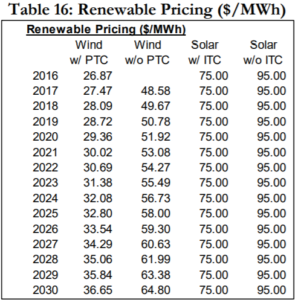Without Subsidies, Wind and Solar Are Still the Most Expensive Energy Sources In Minnesota
Renewable energy advocates often quote the cost of power purchase agreements (PPA) between wind and solar developers and utilities as evidence that wind and solar are the cheapest sources of electricity in Minnesota. However, PPA agreements show the price after federal subsidies are applied, and therefore do not represent the full cost of wind and solar.
Furthermore, documents drafted by Xcel Energy and Otter Tail Power show that once the subsidies are gone, the PPA price of electricity generated from wind and solar is expected to increase substantially.
According to Otter Tail Power, wind energy increases as much as 119 percent without the PTC.
The charts below are from Otter Tail Power’s most recent resource plan, showing the cost per megawatt-hour (MWh) of wind and solar energy based on 20-year purchase power agreements (PPAs).


In 2016, low-cost values for subsidized wind and solar were $25 and $70, respectively.
These subsidized costs are fairly low, and they would be cost-competitive to natural gas and coal generation if it didn’t also need the natural gas or coal generation for when the wind wasn’t blowing.
When Otter Tail projected costs out to 2026 – when the PTC expires entirely and the ITC is lowered from a 30 percent to 10 percent tax credit on investment – the cost of wind energy increased by 119 percent to $54.59, and solar by 25 percent to $94.00.
These values, which represent the cost of wind and solar energy without subsidies, are anything but cost competitive with natural gas and coal prices, which we calculated to be $30.12 and $33.23 per MWh in Minnesota, respectively, based on utility form 1 filings to the Federal Energy Regulatory Commission (FERC).
In fact, these values bring wind and solar energy to the top of the list, as $54.59 and $94.00 are both more expensive than any other baseload energy source available in Minnesota, including coal, combined cycle natural gas, nuclear, and hydroelectric power.
Xcel Energy suggests the same as Otter Tail in their most recent resource plan.

As shown above, the true cost of wind energy in 2019, $50.78 per MWh, is over 75 percent more expensive than the subsidized cost of wind energy at $28.72 per MWh.
Wind and solar energy have been and will continue to be bad investments for the state of Minnesota.
Not only are they the two most expensive energy sources in the state, but they are inherently unable to provide enough power to supply 100 percent of electricity demand throughout the day, as they need backup generation on standby for when the wind isn’t blowing, and sun isn’t shining.
Wind and solar energy are still Minnesota’s most expensive energy sources, despite attempts by renewable advocates to convince the public that renewable energy sources are cost competitive, or even cheaper than coal, nuclear, or natural gas.